New renewable energy sources
All around the world, scientists are working on new ways to use energy from renewable sources that won't cause climate change or damage to the environment.
In this article you can learn about:
- The difference between renewable and non-renewable sources
- Why we need new types of renewable energy
- Some of the new renewable ideas that are being developed
- What the advantages and disadvantages of new renewables are
This resource is suitable for energy and sustainability topics for primary school learners.
Video - What are new renewable energy sources?
Learn about some of the new types of renewable energy in this short video.
Meet Eureka.
She's always searching for clean energy sources to see if they can make her bulb light up!
Sorry, Eureka, benches can't generate power…
You see, most people agree we should stop burning fossil fuels. Which means we need to come up with lots of new, renewable ways to generate power.
Like plants, for example. Us humans think we’re really clever because we can do stuff like make pizza and go to the moon, but plants can do something much more impressive than that - they can convert sunlight directly into chemical energy.
This is called photosynthesis – and it's how plants grow.
They even absorb carbon dioxide from the air while they do it!
Eureka wants to use photosynthesis to help plants make liquid fuel.
She'll have to experiment with the plants a bit first, but she's very optimistic about it, aren't you?
She even thinks we could make robot plants with man-made leaves that capture light energy and store it in chemical form!
Sunlight is the main energy source for our whole planet. And Eureka is really into finding new ways to use it.
Like concentrated solar power. It uses mirrors… lots of mirrors.
They’re set up in a really hot place, like a desert, and angled to reflect sun rays into a central tower.
A special fluid in the tower gets so hot it turns turbines and powers a generator, which produces electricity.
New energy sources might also be found in unlikely places…
It should be possible to make fuel cells that run on human pee!
Some types of bacteria eat waste and give out small amounts of electricity. A Microbial Fuel Cell uses these bacteria like a battery, feeding them waste to generate electrical energy. The people of Scotland produce over 2 billion litres of urine a year – that's a lot of potential power!
So, from photosynthesis to pee power, it’s Eureka who’s going to shape our future!
What are new renewable energies?
The world’s energy comes from two main categories – renewables and non-renewables.
Renewables come from energy sources that can be used over and over again and will never run out. For example wind, solar or tidal energy.
Non-renewables come from energy sources that will eventually run out – such as fossil fuels or nuclear energy.
Many governments have targets to reduce their use of non-renewable energy, especially fossil fuels which are a cause of global heating.
Some renewable energies have been used for years, such as wind, hydroelectric and geothermal energy. However, scientists are always looking to improve how these work and to find new and exciting ways to use different energy sources.

Photosynthesis and man-made plants
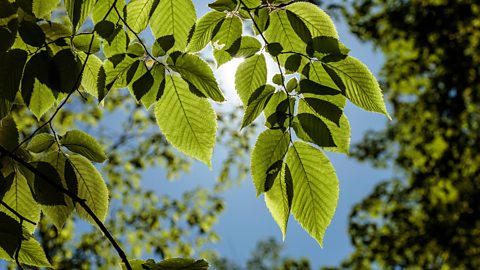
photosynthesisA chemical reaction that takes place in plants. Plants turn carbon dioxide and water into glucose, their main source of energy, and oxygen. Sunlight provides the energy needed for photosynthesis to take place. is the process that allows plants to grow.
It involves plants converting the sun’s energy into chemical energy, absorbing carbon dioxide and giving out oxygen as they do it.
Photosynthesis is great for the environment because it removes carbon dioxide, one of the main greenhouse gasA gas that absorbs heat so that it is trapped in the Earth's atmosphere. Greenhouse gases help keep the Earth warm but increasing amounts of greenhouse gases causes global heating. The main greenhouse gases are water vapour, carbon dioxide and methane .
Scientists are looking into the possibility of making robot plants which could copy the photosynthesis process. Instead of using the energy for growing they would be used to make chemical fuels. They could also remove some carbon dioxide from the atmosphere.
Learn more about photosynthesis here: How do plants get energy and food to grow?

Concentrated solar power
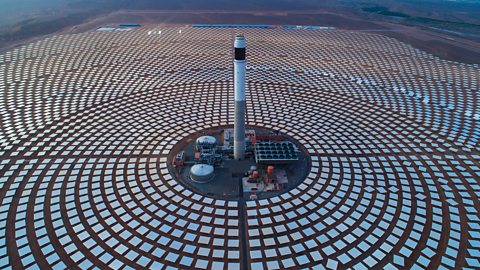
Concentrated solar power also uses the Sun’s energy.
In very hot places, like deserts, lots of mirror panels are set up at different angles to reflect the Sun’s light and heat to the top of a tower.
The tower contains a heat transfer fluidA gas or liquid which can absorb and store heat and transfer this heat energy to where it is needed. which is used to transport heat energy to a boiler. The boiler produces steam which is used to turn a turbineA turbine is a machine that turns the movement of liquid or gas into energy that can be used. In a simple turbine water or air push against turbine blades and spin them round. The spinning blades turn a long pole called a shaft. The shaft can then turn other pieces of machinery, such as a generator that is used to produce electricity. and produce electricity.
This system stores energy so it can keep working for a time if the sky clouds over or when the sun sets.
Learn how solar power uses the energy of the Sun to generate electricity:

Can pee be used to generate electricity?
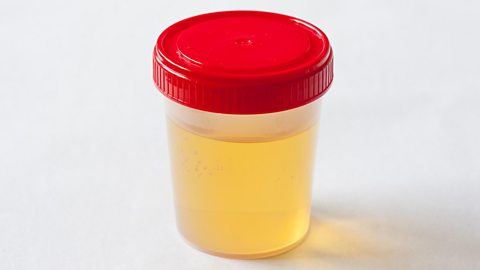
Scientists are developing fuel cells that run on human waste, particularly urine.
Bacteria in the fuel cell feed on waste chemicals in urine. The waste given out by the bacteria can be used to generate electricity, just like the chemicals in a battery.
As long as they keep being supplied with urine, the bacteria will keep making new bacteria and generating electricity.

Why do we need new renewable energy sources?
Many of the world’s richest countries buy lots of the world’s fossil fuels and energy sources. This can leave poorer countries at a disadvantage.
Many poorer countries and rural areas do not have the infrastructureThe basic structures needed for an area to function, for example roads and communications. to supply people with electricity or other energy. 740 million people in the world live without electricity.
Different sources of renewable energy work in different weather and other conditions. Developing new types of renewables could help more countries in the world generate power in different ways. This could give more people access to electricity.
94.7% of Scotland’s electricity demand in 2020 was met by renewable energies but we still use a lot of gas for heating homes and petrol and diesel for cars and transport. Finding new sources of renewable energy might help replace these and could also create jobs for people.
The advantages and disadvantages of new renewable energy
Advantages of new renewable energy
Using renewable energy sources contributes less to climate change and are more environmentally friendly.
Experimental new renewables can help us move towards producing all of our power from renewable sources.
New renewables might help solve problems about storing energy or generating electricity when the weather isn't right for solar, wind or wave energy to work.
Disadvantages of new renewable energy
New renewables are not yet fully developed and there is still a bit of a way to go before they can meet the world’s electricity demand.
Some renewable energy types are not reliable and depend on certain conditions, such as sunlight or the wind.
Developing new ideas can be expensive and not all these ideas might work.

Key words about new renewables
Sorry, something went wrongCheck your connection, refresh the page and try again. - The type of energy generated by sources of renewable energy which do not give off emissions that are harmful to the environment.
Sorry, something went wrongCheck your connection, refresh the page and try again. - Fuels that come from the Earth. Fossil fuels are all old life forms that have decomposed and been compressed over a long period of time under ground or under the sea. Coal, oil and gas are fossil fuels.
Sorry, something went wrongCheck your connection, refresh the page and try again. - The process by which green plants produce their own food using sunlight, water and carbon dioxide.
Sorry, something went wrongCheck your connection, refresh the page and try again. - All substances are made of chemicals. The way these are joined together can store energy. This is called chemical energy. This energy can be released when there is a chemical reaction, for example when fuels are burned.
Sorry, something went wrongCheck your connection, refresh the page and try again. - A gas, in its most common form, that is found in the Earth’s atmosphere. It is a greenhouse gas that can be harmful to the environment as it contributes towards global warming.
Sorry, something went wrongCheck your connection, refresh the page and try again. - A simple turbine has a shaft and blades that turn movement into energy. Usually water or air push the blades and turn the shaft. Turbines are used to turn the generator.
Sorry, something went wrongCheck your connection, refresh the page and try again. - A machine that is used to make electricity. When the generator head is turned, this energy is converted to electrical energy.
Sorry, something went wrongCheck your connection, refresh the page and try again. - The change in the usual conditions of weather (temperature, wind, rainfall etc.) on Earth over a long period of time. The climate has changed throughout the history of Earth, but current climate-change refers to an increase in global temperature.
Sorry, something went wrongCheck your connection, refresh the page and try again. - The increase in the Earth's average temperature due to the greenhouse gases released in to the environment when people burn fossil fuels.
Test your knowledge
Quiz
Challenge

Design a new way to generate electricity using kinetic energy and turbines
Most of the renewable energy types involve using kinetic energy to turn a turbine and a generator to produce electricity. Can you think of a new idea that uses the kinetic energy of something to turn a turbine?
For example, in wind power, the kinetic energy of the wind turns the blades of a windmill, which turns a turbine. Or in tidal power, the kinetic energy of the moving water turns turbines.Draw out your idea, thinking carefully about:
- The source of kinetic energy
- The different parts of machinery that might be needed (E.g., a turbine and a generator)
- How reliable the source of energy is
Generating electricity. videoGenerating electricity
Find out how turbines and generators generate electricity.
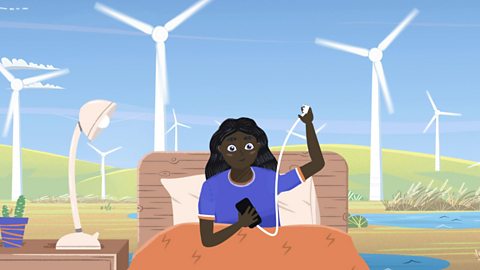
More on Energy sources and sustainability
Find out more by working through a topic
- count1 of 14

- count2 of 14
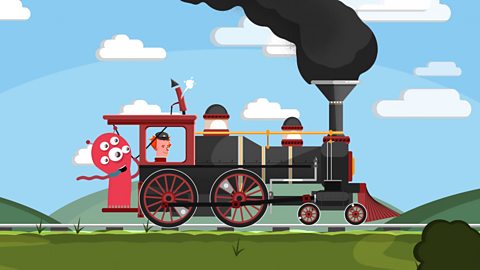
- count3 of 14

- count4 of 14
